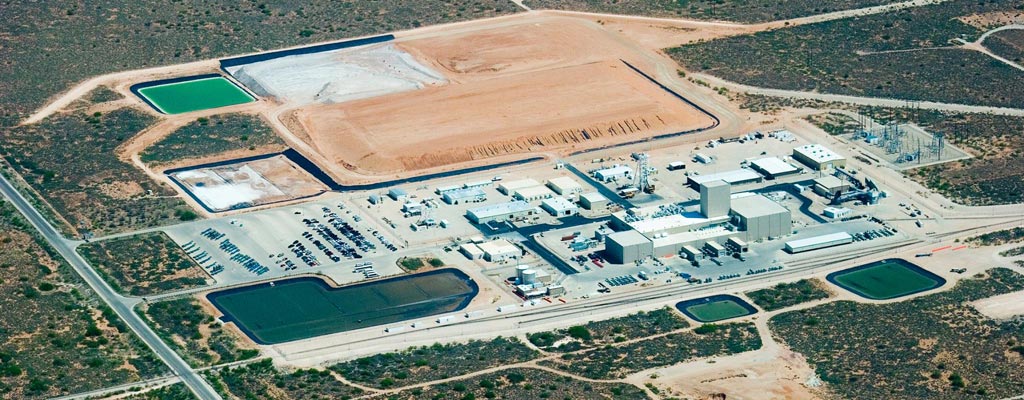An NWMO geoscientist examines core samples pulled from rock in South Bruce, Ontario, as part of investigations of a potential deep geological repository. (Photo: NWMO)
Canada’s Nuclear Waste Management Organization (NWMO) has completed a deep borehole drilling program at the two sites in Ontario under investigation for potentially hosting a deep geological repository to hold the country’s spent nuclear fuel. The NWMO said that Canada’s top geoscientists are leading the studies, in which approximately eight kilometers of core samples were pulled from the bedrock in the Wabigoon-Ignace area and the Saugeen Ojibway Nation (SON)–South Bruce area.
The USS Enterprise (CVN-65)
The Naval Academy ANS student section, with support from the Washington, D.C., local section, held its semiannual dinner on March 29 in Annapolis, Md. The event was attended by more than 100 people, including midshipmen, professors from the U.S. Naval Academy, local ANS members, and ANS President Steve Nesbit.
The evening’s program was hosted by the student chapter president, Midshipman First Class Sara Perkins, and was headlined by the director of the Naval History and Heritage Command, Rear Admiral (retired) Samuel Cox.
The Department of Energy's Waste Isolation Pilot Plant, in New Mexico. (Photo: DOE)
The Waste Isolation Pilot Plant’s Emergency Operations Center (EOC) and Joint Information Center (JIC) were activated on April 9 following an abnormal event that occurred during routine waste handling at the Department of Energy’s WIPP repository for transuranic waste, near Carlsbad, N.M.
Pictured from left to right: John Tappert, NRC; Jonathan Rowley, NRC; Jacob Zimmerman, NRC; Matthew Bartlett, NRC; Tim Beville, DOE; Jennifer Wheeler, TRISO-X; John Lubinski, NRC; Pete Pappano, TRISO-X; Jill Caverly, NRC; and Shana Helton, NRC. (Photo: X-energy)
An NRC diagram of a LLW waste disposal site.
The Nuclear Regulatory Commission will integrate two separate rulemaking activities concerning the disposal of low-level radioactive waste, issuing a “re-proposed” rule that consolidates updates to 10 CFR Part 61, “Low-Level Radioactive Waste Disposal,” and proposed changes to the requirements for the near-surface disposal of greater-than-Class C (GTCC) waste.
The Diablo Canyon nuclear power plant. (Photo: Doc Searls)
Officials in California are planning to replace the electricity produced by the Diablo Canyon nuclear power plant, scheduled to shut down in 2025, “mostly with Wyoming coal-fired generation.” That claim is made in a post on the Capitol Weekly website written by Gene Nelson, a cofounder of Californians for Green Nuclear Power (CGNP). Nelson writes that although state officials are trying to hide this plan from the public, CGNP uncovered it by detecting four obscure clues in California Public Utilities Commission (CPUC) filings.
Ingots of HALEU derived from pyroprocessing of EBR-II driver fuel at Idaho National Laboratory. (Photo: INL)
On April 7, U.S. Sen. John Barrasso (R., Wyo.), ranking member of the Senate Committee on Energy and Natural Resources, introduced the Fueling Our Nuclear Future Act of 2022. The bill would ensure a domestic supply of high-assay low-enriched uranium (HALEU) for advanced nuclear reactors by directing the Department of Energy to prioritize establishing a domestic HALEU enrichment capability and to use enriched uranium held by the DOE and the National Nuclear Security Administration to fuel advanced reactor demonstrations until U.S. commercial enrichment is available. The bill explicitly excludes uranium sourced or processed by any entity owned or controlled by the governments of Russia and China.
Ontario clean energy leaders. From left: John Gorman, president and chief executive officer of the Canadian Nuclear Association; Ken Hartwick, president and CEO of Ontario Power Generation; Todd Smith, Ontario’s minister of energy; and Mike Rencheck, Bruce Power president and CEO. (Photo: Bruce Power)
Bruce Power and Ontario Power Generation (OPG) have announced an agreement to work together to support new nuclear technologies in Ontario. Bruce Power operates the Bruce nuclear plant and OPG operates the Darlington and Pickering facilities.
Attending the MOU signing on April 5 are, from left, Franc Škrabec, Numip, nuclear power program manager; Tine Ogorevc, Numip, general manager; Josefa Arcarons Coma, Westinghouse, global supply chain manager for the Europe, Middle East, and Africa region; Elias Gedeon, Westinghouse, senior vice president of commercial operations; Joel Eacker, Westinghouse, vice president of new power plant projects; Mojca Lorber, Sipro Engineering, commercial manager; Metod Pirc, Elmont, general manager; and Franc Katič, Sipro Engineering, general manager. (Photo: Westinghouse)
Westinghouse’s plans for supplying AP1000 reactors to Ukraine may have been complicated by Russia’s invasion of the country, but the company is nonetheless continuing its efforts to strengthen business ties in Central and Eastern Europe. On April 5, Westinghouse signed memorandums of understanding with three companies in Slovenia.
A robot called Lyra was used to survey an underground radioactive ventilation duct in Dounreay’s redundant laboratories. (Photo: NDA)
Dounreay Site Restoration Ltd. (DSRL) and the Robotics and Artificial Intelligence in Nuclear (RAIN) Hub, a consortium of universities led by the University of Manchester, are working together on the development of robots capable of accessing areas that are inaccessible or unsafe for humans to work in. The robots will be used to inspect and characterize Dounreay’s laboratories, buildings, and structures as the United Kingdom prepares to decontaminate and decommission the nuclear site.
Energy Harbor’s Perry nuclear power plant, in Perry, Ohio. The company says its nuclear units are “critical infrastructure required for the U.S. clean energy transition.”
Energy Harbor—owner and operator of the Beaver Valley, Davis-Besse, and Perry nuclear power plants—recently announced its plan to become a carbon-free energy infrastructure and supply firm in 2023. Energy Harbor is based in Akron, Ohio.
















,_July_2020.jpg)
 The Nuclear Regulatory Commission yesterday unveiled its
The Nuclear Regulatory Commission yesterday unveiled its